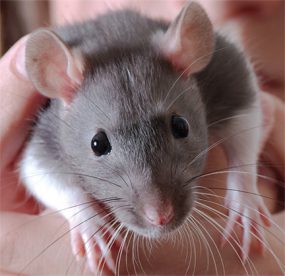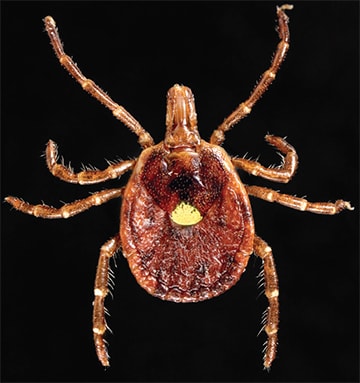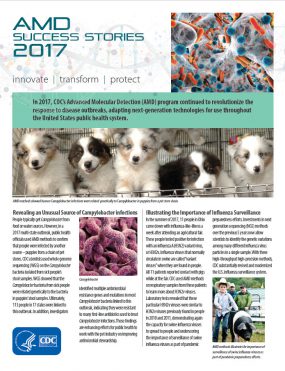AMD Activities: 2017
- Unusual Source of Campylobacter infections
- Healthcare Associated Fungal Infections
- Influenza Surveillance
- Seoul Virus Found in Pet Rats
- Tracing Emerging Poxvirus Outbreaks
- Linking Bourbon Virus to Ticks
- Expanding AMD to State Public Health Laboratories
- State Public Health Laboratories Tracing Hepatitis
- PulseNet Foodborne Disease Surveillance
People typically get Campylobacter from food or water sources. However, in a 2017 multi-state outbreak, public health officials used AMD methods to confirm that people were infected by another source – puppies from a chain of pet stores. CDC scientists used whole genome sequencing (WGS) on the Campylobacter bacteria isolated from sick people’s stool samples. WGS showed that the Campylobacter bacteria from sick people were related genetically to the bacteria in puppies’ stool samples. Ultimately, 113 people in 17 states were linked to this outbreak. In addition, investigators identified multiple antimicrobial resistance genes and mutations in most Campylobacter bacteria linked to this outbreak, indicating they were resistant to many first-line antibiotics used to treat Campylobacter infections. These findings are enhancing efforts for public health to work with the pet industry on improving antimicrobial stewardship.

Discovered in the U.S. in 2016, multidrug-resistant Candida auris is a serious threat in healthcare settings. Cases of C. auris infection have been identified in 10 states across the United States with a total of 174 confirmed cases and 29 probable cases as of December 2017. This fungus can persist on surfaces, requiring specialized disinfection to kill it. In 2017, a Massachusetts healthcare laboratory suspected C. auris in a patient who had recently received a lung transplant. The laboratory raised the alarm and alerted the facility’s infection control team and the state epidemiologist. The team submitted patient samples to CDC. Using AMD technologies, CDC was able to help link the strain of C. auris back to the organ donor in another state where an outbreak was occurring, alleviating concerns that the Massachusetts facility was the source of the infection.

In the summer of 2017, 11 people in Ohio came down with influenza-like-illness a week after attending an agricultural fair. These people tested positive for infection with an influenza A(H3N2) variant virus, or H3N2v. Influenza viruses that normally circulate in swine are called “variant viruses” when they are found in people. All 11 patients reported contact with pigs while at the fair. CDC used AMD methods on respiratory samples from these patients to learn more about H3N2v viruses. Laboratory tests revealed that these particular H3N2v viruses were similar to H3N2v viruses previously found in people in 2010 and 2011, demonstrating again the capacity for swine influenza viruses to spread to people and underscoring the importance of surveillance of swine influenza viruses as part of pandemic preparedness efforts. Investments in next generation sequencing (NGS) methods over the previous 5 years now allow scientists to identify the genetic variations among many different influenza virus particles in a single sample. With these high-throughput high-precision methods, CDC substantially revised and modernized the U.S. influenza surveillance system.
In December 2016, an unusual outbreak came to light after a home-based pet rat breeder in Wisconsin was hospitalized. CDC tested a blood specimen and confirmed that the person’s infection was caused by Seoul virus, a hantavirus carried by Norway rats worldwide. A follow-up investigation identified 31 pet rat breeding facilities in 11 states with Seoul virus infections in rats or people. Testing identified 17 people with recent Seoul virus infection. Three people were hospitalized. AMD techniques proved critical in tracing this outbreak. Whole genome sequencing by CDC determined that the strain of virus making the rats and people sick was closely related to a strain of Seoul virus previously found in pet rats in the United Kingdom. These data helped investigators understand that the outbreak likely stemmed from the international pet trade, rather than transmission of Seoul virus from wild rats to pet rats in this country.

AMD methods helped identify domesticated rats as the source of an unusual outbreak of Seoul virus infections.
Monkeypox re-emerged in Nigeria in 2017 for the first time since the 1970s. The outbreak was the largest ever recorded in Nigeria, with monkeypox cases appearing simultaneously in several different areas. As local health officials responded to the outbreak, they were concerned that cases may have been imported from other countries in Central Africa. CDC scientists used AMD methods to sequence the virus. The genetic data they found demonstrated that the outbreak was due to a Nigerian virus and that several genetically distinct strains were involved. Though monkeypox did appear to spread among people in the affected communities, genetic data showed there were multiple smaller outbreaks, not one widespread outbreak. This suggests that the clusters were likely the result of separate transmissions of monkeypox from animals to people.
AMD methods helped CDC scientists first detect Bourbon virus in a human blood sample in 2014. Because the sample had come from a patient with suspected tick-associated illness, they assumed that the person became sick from a tick bite. In 2017, CDC scientists sequenced samples from over 39,000 ticks collected in the wild in 2013. AMD and other laboratory methods helped them detect Bourbon virus in ticks for the first time, providing further evidence that Bourbon virus might be transmitted to people by ticks.


The Minnesota Department of Health has been partnering with CDC and the Mayo Clinic to better identify tickborne Borrelia infections across the United States using AMD methods. Borrelia bacterial species include two different subgroupings that cause human disease. One of these groupings causes relapsing fevers and the other causes Lyme disease, the most common tickborne disease in the United States. In 2017, investigators discovered a bacterium, Borrelia johnsonii, in a human for the first time. This bacterium previously was thought to be found only in bat ticks. A better understanding of the type and geographic distribution of Borrelia bacteria species infecting humans is essential for improving clinical recognition of disease, laboratory diagnosis, and prevention.

In 2017, the Connecticut Department of Public Health (CDPH) used AMD methods to sequence bacterial species from two people who reported having diarrhea after returning from international travel. The two people were not related, took trips to the same country a month apart, and did not share any specific exposures. CDPH sequenced Escherichia coli from one person and Salmonella enterica serotype Enteritidis from the other and uploaded genetic data to the National Center for Biotechnology Information (NCBI). NCBI identified the mcr-1 resistance gene in genetic data from the two bacterial isolates. The mcr-1 gene causes resistance to colistin, a last-line antibiotic used to treat multidrug-resistant infections. Plus, mcr-1 is harbored on plasmids, which can be shared among bacterial species. CDC scientists conducted further sequencing that identified identical plasmids containing mcr-1 from the two cases. CDPH and CDC collaborated to assess possible routes of exposure to mcr-1 and potential spread to the environment, but found none. These investigations highlight the importance of using AMD technologies to detect emerging resistance, identify global resistance threats, and prevent the spread of resistance in the United States.
Through AMD investments, CDC hepatitis experts developed a custom NGS approach for sequencing hepatitis C virus (HCV) and launched the Global Hepatitis Outbreak and Surveillance Technology (GHOST). GHOST is a cloud-based system that integrates NGS data with bioinformatics and information technologies. Regardless of computer expertise, GHOST users can conduct cost-effective, accurate HCV molecular surveillance. CDC is currently training states on how to use AMD methods and upload NGS sequence data into GHOST. Because of this training, participating state public health laboratories used GHOST in 2017 to identify outbreaks on their home turf.
Since 2013, CDC has been helping state and other federal laboratories build capacity to use AMD methods, like whole genome sequencing (WGS), for foodborne outbreak surveillance. The CDC PulseNet team has developed standard procedures for WGS, trained over 350 public health laboratory scientists on WGS laboratory and analysis methods, and facilitated WGS certification for PulseNet laboratories. As of December 2017, the PulseNet team has certified 48 public health laboratories in 40 states for WGS of foodborne Listeria, Shiga toxin-producing Escherichia coli (STEC), Salmonella, and Campylobacter. In addition, the PulseNet program is on track to complete the transition to WGS in all 50 states for all major bacterial foodborne pathogens by the end of 2018.

